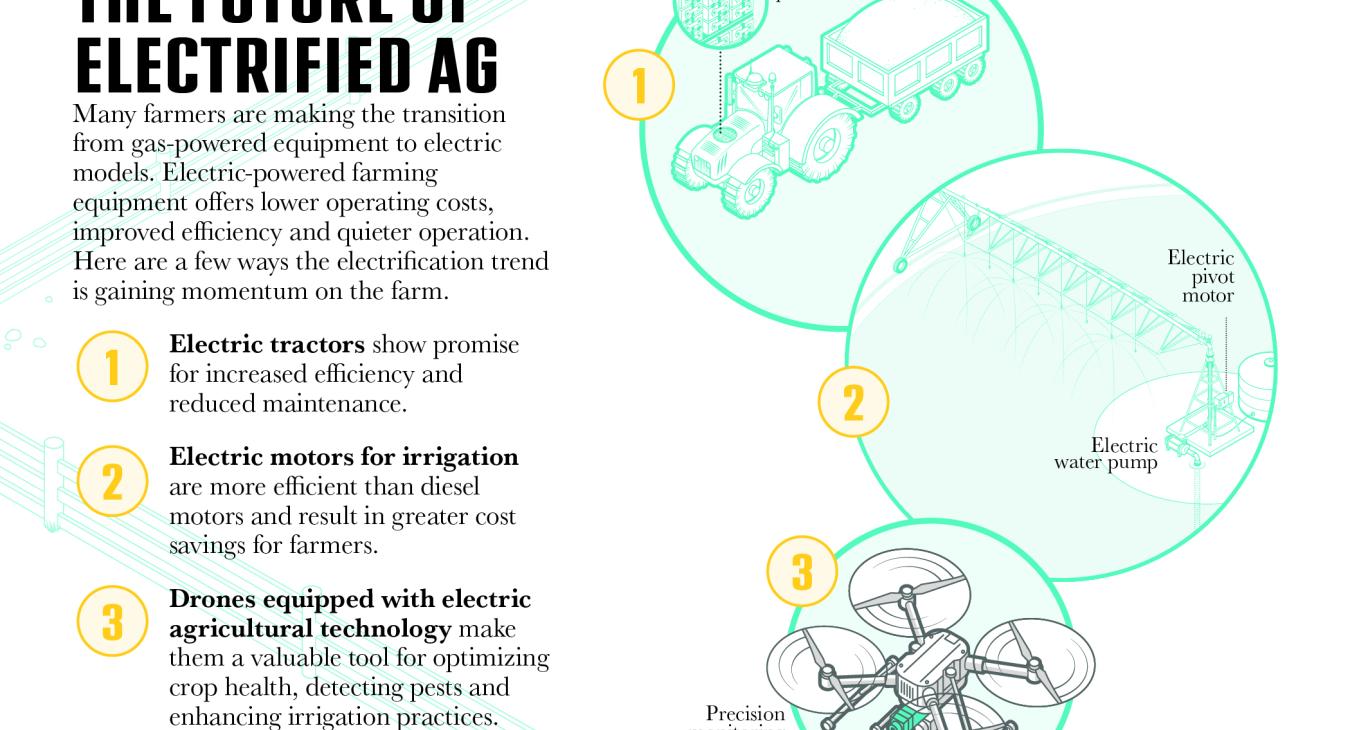The electrification trend in agricultural equipment has gained momentum in recent years as farmers increasingly embrace electric vehicles and machinery. This shift offers numerous advantages, including reduced carbon emissions, lower operating costs, improved energy efficiency and quieter operation.
Smaller electric equipment, such as irrigation systems and utility vehicles, are becoming increasingly popular. Many farmers are now using electric motors in place of older, inefficient diesel irrigation motors for farm irrigation.
Larger agricultural equipment can be difficult to replace with electric alternatives due to their weight. In response, manufacturers are developing tractors that are more compact, lower in weight and feature battery-powered options. The compact and lighter design of these tractors allow for better maneuverability in smaller farming spaces, improving efficiency and productivity in the field. For example, a farmer who owns a small orchard may opt for a compact electric tractor instead of a larger, traditional tractor. The smaller size and electric power allow the farmer to easily navigate between rows of trees without causing damage to the delicate fruit or soil, ultimately increasing the yield and reducing maintenance costs.
In addition to smaller equipment, drones equipped with electric agricultural technology are proving to be valuable in many cases. Electric drones provide farmers with the ability to monitor crops, perform precision spraying and even participate in crop pollination. Equipped with specialized sensors and cameras, these drones capture high-resolution imagery to help farmers make informed decisions about crop management. The versatility and cost-effectiveness of electric drones make them a valuable tool for optimizing crop health, detecting pests and enhancing irrigation practices.
Electrified agricultural equipment can be used in various types of farming operations
Here are some common types of farming operations that benefit from electrified agricultural equipment.
Crop Farming: Electric equipment such as tractors, sprayers and harvesters are used in crop farming operations for tasks like plowing, planting, spraying pesticides, drying and harvesting crops.
Livestock Farming: Electric equipment can be utilized in livestock farming for tasks such as feeding, milking and waste management.
Vineyards and Orchards: Electric pruning equipment can be utilized in vineyards and orchards for precision pruning of grapevines, fruit trees and bushes.
Greenhouses and Nursery Operations: Electric equipment like tillers, seeders and potting machines are often used in greenhouse and nursery operations for efficient soil preparation, seeding and transplanting.
Organic Farming: Electrified agricultural equipment is also used in organic farming operations, with a focus on sustainability and environmentally-friendly practices. Electric tools and equipment help minimize the use of fossil fuels and reduce emissions.
Benefits of Electrified Ag Equipment
Electrified agricultural equipment offers several benefits beyond reducing carbon emissions.
Electric drive trains are simpler and easier to maintain compared to traditional tractors, resulting in lower maintenance costs. Additionally, electric equipment is more energy efficient, converting a higher percentage of electrical energy into usable work.
Electric drive trains are radically simpler than modern tractors making maintenance cheaper and easier. Electricity flowing through batteries and electric motors is more efficient than diesel being delivered to farms, moved into tanks and burned in diesel engines, and as battery technology continues to advance, further improvements in electric farming equipment are expected.
This efficiency leads to reduced energy consumption and lower operating costs for farmers. Additionally, the quieter operation of electric equipment minimizes disruptions to nearby communities, livestock and wildlife, making it ideal for residential areas or sensitive environments.
Considerations for Farmers
When considering electrified equipment, farmers should evaluate their specific needs, including power requirements and operational tasks. Farmers should work with their local electric cooperative to assess the farm's power supply capacity to ensure it can handle the additional load without causing issues. By conducting a thorough analysis of their unique needs and goals, farmers can determine if adopting electrified agricultural equipment is a suitable and advantageous option.
The electrification of agricultural equipment presents a promising future for farmers. By embracing electric vehicles, machinery and drones, farmers can improve operational efficiency and benefit from cost savings in the long run.

